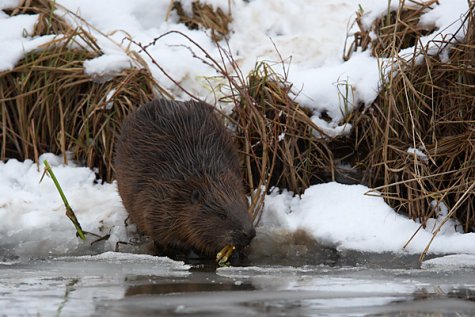Beaver activities can be seen
Photo: Sven Začek, Zacekfoto
Translation: Liis
Beaver replenishing winter stores
Beaver Kobras or piiber Castor fiber
In late winter beavers become mobile. Several reasons: food stocks are getting low and the heat period is beginning. At the banks of inland waters fresh tracks and traces of activities can be seen in the snow – shrubs or their bark are being chewed, territories are marked; the animals can be met at these doings even in daytime. The print of the hind paw of our largest rodent is big, some fifteen centimetres long, width about ten centimetres thanks to the webbing between the hind toes. The prints of the forepaw, without webbing but toes held spread out, are about five centimetres; both feet leave five strong claw marks. The flat and broad tail leaves a clear drag trace in the snow and on moving the animal can erase some of the footprints with the tail.
For food they now look for willow, aspen, rowan, birch or bird cherry bark and in winter coprophagy occurs among beavers as among hares, to extract nutrients better from scarce food. Beavers are strictly herbivores.
The beaver family has spent the winter together with the juveniles born in June of last year; these will soon establish their independent life. At waters with low banks we can find nest lodges piled up more than a couple of meters in height. At rivers or trench sections with higher banks they dig dens in the bank, but always so that the nest can only be entered from under water. The lodge itself is quite spacious consisting of a living and dining room with a pool, and sleeping chambers. The adults may weigh up to thirty-five kilos and the juveniles from last year about six kilos – the animals, known as skilled builders, need rather much living space.
Wolves as well as lynxes kill beavers in late winter by stalking them.









